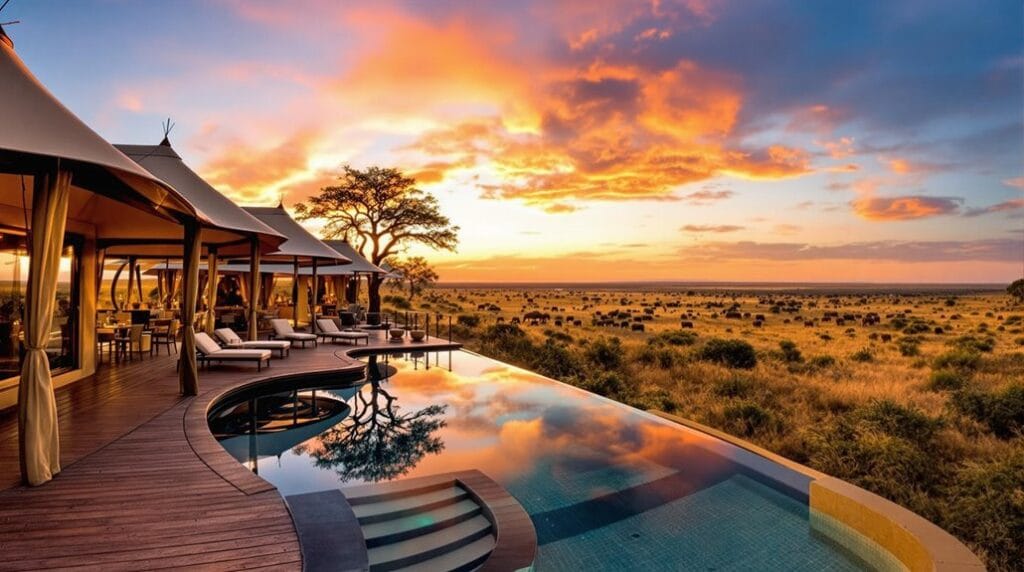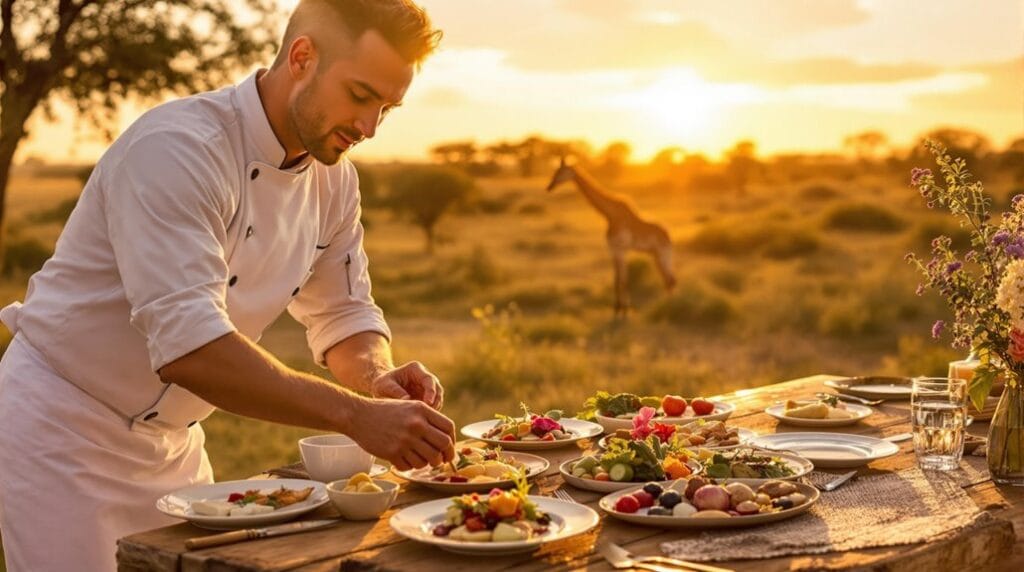Like a pulse beneath the surface, Africa's festival dance resonates with centuries of tradition and storytelling. You might find yourself captivated by the intricate movements that reflect cultural identity and communal values. Each dance style, from the spirited Zulu dances to the rhythmic beats of the Djembe, discloses layers of meaning and connection. Yet, as you explore further, questions arise about how these vibrant expressions evolve in the modern world, and what they reveal about the resilience and unity of communities across the continent.
Key Takeaways
- African festival dance embodies diverse styles, reflecting the continent's rich cultural heritage and communal narratives through unique movements and rhythms.
- Drumming acts as the heartbeat of these dances, guiding performers and enhancing storytelling through intricate rhythmic patterns.
- Traditional dances foster community unity, strengthening intergenerational bonds and collective identities among participants across various social boundaries.
- Globalization has led to the fusion of traditional and contemporary dance forms, enriching cultural expressions and fostering international collaborations.
- Dance serves as a tool for social change, addressing modern issues while preserving cultural heritage and community spirit through vibrant performances.
Diversity of Dance Styles
The richness of African dance is a vivid tapestry woven from diverse styles that encapsulate the continent's cultural heritage. You'll find that each region boasts unique dance forms, reflecting the vibrancy of African culture and its rich traditions.
For instance, the Gnawa dance from Morocco immerses you in spirituality, accompanied by traditional instruments that echo ancestral rhythms. Meanwhile, the Gumboot dance from South Africa bursts forth from the mines, turning wellington boots into powerful percussion.
As you explore further, the high-energy Moribayasa from Guinea captivates with acrobatic displays mainly by women, showcasing strength and grace. In contrast, the Zulu Indlamu dance presents a powerful portrayal of warrior-like movements, steeped in history and pride.
The Setapa dance of the Tswana-speaking people mimics animal stances through intricate footwork, celebrated during harvest festivals. The Bata dance of the Yoruba people and the Eskista dance from the Amhara people narrate complex cultural stories through their distinctive movements.
Each dance style reveals a unique chapter in the narrative of African diversity, inviting you to experience a world alive with rhythm and meaning.
Importance of Music and Rhythm
In African festival dance, drumming forms the heartbeat of the performance, with instruments like the djembe setting the tempo that guides every dancer's step.
You'll notice how the rhythmic patterns tell stories, echoing the cultural values and experiences of the community.
This connection between music and movement creates an atmosphere of collective celebration, where every beat invites participation and emotional expression.
Drumming as Foundation
Drumming pulses at the heart of African dance, infusing every movement with a dynamic rhythm that speaks to the soul. When you listen closely, you'll hear how instruments like the djembe and ngoma set the tempo, guiding dancers through intricate expressions of their cultural heritage.
Each region in Africa boasts unique rhythmic patterns, echoing the community's history and values, creating a vibrant tapestry of sound and motion.
As the drumming fills the air, traditional songs and clapping weave into the fabric of the performance, enhancing the immersive experience. This interplay between music and dance isn't just for entertainment; it serves as a powerful medium for storytelling, allowing you to connect deeply with the narratives of the people.
You can feel the pulse of the community, as each beat resonates with shared memories, traditions, and social issues.
In this way, drumming embodies the rhythms of Africa, uniting performers and audiences alike. It offers a sense of belonging, as you find yourself swept up in the collective heartbeat of a culture that values expression, connection, and the profound impact of rhythm on life itself.
Musical Storytelling Elements
Music and rhythm are woven into the very fabric of African dance, serving as essential conduits for storytelling. When you experience drumming, such as the pulsating beats from the djembe or ngoma, you're not just hearing sounds; you're tapping into a rich tapestry of cultural events that resonate deeply within communities. Each rhythmic beat creates a dialogue between musicians and dancers, guiding movements that are infused with energy and emotion.
Musical storytelling thrives in this dynamic interplay, where traditional songs and clapping envelop participants in an immersive atmosphere. You can feel how each note communicates historical narratives and cultural values, forming connections that transcend words. As you watch the dancers move, their expressions mirror the intricate rhythms and melodies, allowing you to feel a shared sense of history and belonging.
In communal gatherings, rituals, and celebrations, music fosters unity, turning individual experiences into collective memory. The drumming not only sets the tempo but also creates a heartbeat for the community, reminding you of the importance of these cultural elements in preserving identity and shared heritage.
Through this vibrant expression, you become part of a living narrative, celebrating the essence of African culture.
Cultural Narratives Through Dance
While many may see African dance merely as a form of entertainment, it serves as an essential storytelling medium that encapsulates the rich cultural narratives of diverse communities. Each unique dance, whether it's the Baule dance of Ivory Coast or the Eskista of Ethiopia, reflects the distinctive traditions, beliefs, and social structures woven into the fabric of everyday life.
Through intricate movements, dancers narrate myths, historical events, and communal values, bringing shared experiences to life.
Costume choices play an integral role, often symbolizing cultural heritage and the significance of the occasion. These vibrant outfits not only enhance the visual spectacle but also deepen the storytelling aspect, creating a visual language that resonates with the audience.
In this context, dance serves as a living archive, preserving traditional movements and rhythms passed down through generations. It's a profound way for communities to maintain their cultural identity and collective memory.
The interplay of music and dance during these communal celebrations enriches the narrative experience, with drumming and singing providing emotional depth, allowing you to feel the heartbeat of history and the spirit of unity in every performance.
Community and Social Connection
When you step into an African festival dance, you can feel the unity that pulses through the crowd, binding generations together.
Each movement not only celebrates cultural heritage but also fosters connections that transcend age and social boundaries, inviting everyone to participate in a shared experience.
As you join in, you become part of a living tapestry that honors history and strengthens community ties.
Unity Through Dance
Dance serves as a vibrant thread weaving together the fabric of African communities, where collective movements and rhythms create a powerful sense of unity. When you participate in community gatherings—be it weddings, funerals, or harvest festivals—you find yourself immersed in a rich tapestry of shared identity.
Traditional dances like Moribayasa from Guinea or Indlamu from South Africa engage everyone, transcending age, gender, and social status. As you join in, the air fills with clapping and singing, enhancing connections among individuals. This communal aspect transforms dance into more than mere performance; it becomes a celebration of life itself.
Many African dances tell stories, preserving cultural narratives that strengthen community bonds and collective memory. Festivals like the AfroVibes Festival showcase this unity, highlighting the role of African dance in fostering collaboration within the Pan-African community.
Through these vibrant expressions, you not only appreciate diverse cultural backgrounds but also feel a profound sense of belonging. In every beat, every step, and every shared smile, dance unites you with others, reminding you of the strength found in community and the joy of collective expression.
Celebrating Cultural Heritage
In the heart of African communities, celebrations breathe life into cultural heritage, revealing the intricate connections that bind people together. Dance serves as a crucial expression, unifying individuals during significant events like weddings, funerals, and harvest festivals. As you participate, you'll notice how the rhythms echo the stories of your ancestors, preserving historical narratives and cultural values. It's through these movements that traditions flow from one generation to the next.
Engaging in dance encourages a profound sense of belonging, transcending barriers of age, gender, and social status. Everyone is invited to join in, fostering a shared identity that strengthens community ties. When you witness a festival filled with vibrant dance, you're not just an observer; you become part of an immersive experience that enhances the spirit of togetherness.
Moreover, the integration of traditional dance forms into contemporary cultural events emphasizes the ongoing relevance of African heritage. It's a celebration of identity and pride, where the rhythms you move to connect you to a larger narrative. In these moments, you'll find that dance isn't just an art form—it's the heartbeat of community, echoing the crucial bonds that hold you together.
Intergenerational Connections
Celebrations often create a vibrant tapestry of intergenerational connections, where the rhythmic movements of traditional dance serve as a bridge linking the past to the present. When you participate in community celebrations like weddings or harvest festivals, you're not just enjoying the festivities; you're engaging in a living history. Each step and beat resonates with the stories and traditions passed down through generations, fostering a deep sense of belonging.
In these moments, the dynamic nature of African dance encourages everyone—young and old—to come together, transcending age, gender, and social status. As older generations share their narratives through dance, you find yourself enriched, learning about cultural heritage in ways that words alone can't convey.
The collaborative dances and communal rituals reinforce not just individual identities, but collective memory, reminding you that you're part of something larger. These intergenerational connections are essential for resilience and solidarity, strengthening the fabric of your community.
They highlight the importance of sharing experiences, creating a bond that weaves together the past, present, and future, ensuring that the rhythms of tradition continue to pulse through the heart of your community.
Traditional Dance Forms Explored
Across the vibrant landscapes of Africa, traditional dance forms serve as essential expressions of cultural identity and community connection. Each dance tells a story, showcasing the rich heritage of the people.
Take the energetic Gumboot dance from South Africa, for instance. Born in the mines, African dancers use wellington boots to create rhythmic sounds, connecting labor with artistry.
Then there's the Moribayasa dance from Guinea, where high-energy, acrobatic movements primarily performed by women celebrate community and culture, embodying resilience and joy.
The Zulu's Indlamu dance stands out with its powerful, warrior-like movements that reflect strength and bravery, inviting you to feel the pride of the performers.
As you explore the Bata dance of the Yoruba, intricate rhythmic patterns and vibrant costumes serve as a communication tool with the deity Sango, bridging the spiritual and the earthly.
Finally, the Eskista dance from Ethiopia captivates with its distinctive shoulder movements, expressing joy at weddings and cultural events.
In these traditional dance forms, African dancers weave a tapestry of meaning, inviting you to share in their collective experience, and forging connections that resonate across generations.
Modern Influences on Dance
You'll notice how globalization has reshaped African dance, blending traditional movements with contemporary styles that resonate with younger audiences.
Technology plays a vital role too, as social media platforms allow these vibrant forms to reach a global stage, fostering new connections and collaborations.
This fusion not only celebrates the rich history of African dance but also pushes its evolution in exciting directions.
Globalization and Dance Evolution
Globalization has transformed the landscape of African dance, blending traditional elements with modern influences that appeal to both local and international audiences.
You'll notice that contemporary performances now often feature vibrant costumes that fuse contemporary fashion with traditional attire, creating a fresh aesthetic that resonates with younger viewers. Social media platforms play a vital role in this evolution, granting traditional African dances global visibility and facilitating a rich exchange of styles.
As you observe performances, you might see classic African techniques intertwined with modern choreography, demonstrating the adaptability of these art forms. This fusion not only draws diverse audiences but also enriches the cultural narrative surrounding African dance.
Collaborations between African dancers and international artists further enhance this dynamic, leading to exciting cross-cultural exchanges that influence both traditional and contemporary practices.
While efforts to preserve the essence of traditional African dance remain strong, the incorporation of modern artistic expressions reflects the fluid nature of cultural identity in our globalized world.
This balance allows you to appreciate the deep roots of African dance while embracing its ever-evolving nature, fostering a sense of belonging in an increasingly interconnected cultural landscape.
Technology's Role in Performance
In the domain of African dance, technology's transformative influence becomes immediately apparent, reshaping how performances are conceived and experienced. You'll notice how digital platforms have broadened the reach of traditional African dance, allowing diverse audiences to connect with these vibrant forms from anywhere in the world.
Social media, particularly Instagram and TikTok, has emerged as a crucial stage where dancers showcase their skills, igniting trends that propel specific movements into the global spotlight.
Imagine the thrill of engaging with virtual reality and augmented reality experiences, where you're not just a spectator but an active participant in immersive performances. These innovations invite you to feel the rhythms and stories that traditional dances convey, deepening your connection to the culture.
Moreover, online workshops have become a bridge, allowing you to learn traditional styles directly from skilled practitioners, fostering a global community of dance enthusiasts.
With the integration of modern sound and lighting technology, performances have transformed into dynamic experiences that captivate diverse audiences, enhancing your appreciation for the art form. This blend of tradition and technology creates a rich tapestry, inviting you to explore and belong to the ever-evolving world of African dance.
Key Figures in African Dance
Key figures in African dance have greatly shaped its evolution and global recognition, blending traditional elements with contemporary influences. These dancers and choreographers serve as essential conduits for cultural storytelling, ensuring the rich heritage of African dance is celebrated and preserved.
| Dancer/Choreographer | Contribution |
|---|---|
| Jimi Solanke | Blends traditional Nigerian dance with modern styles |
| Germaine Acogny | Innovator in African dance on the global stage |
| Gregory Maqoma | Fuses traditional African dance with contemporary techniques |
| Fatou Traoré | Preserves and showcases the significance of Malian dance |
As you explore the works of these influential artists, you'll notice how they infuse their dance forms with narrative depth and cultural significance. The late Asadata Dafora was crucial in introducing African dance to Western audiences, creating a bridge between cultures. Meanwhile, Ousmane Sy's workshops foster global appreciation for traditional West African styles. Each of these figures embodies a commitment to both heritage and innovation, inviting you to experience the vibrancy and storytelling inherent in African dance. Their legacies inspire a sense of belonging within the larger tapestry of global dance culture.
Dance as a Tool for Change
Throughout history, dance has emerged as a powerful tool for change within African communities, addressing pressing social issues and injustices. You'll find that traditional dances, often performed by women, serve as essential platforms for activism. These performances are more than just forms of entertainment; they resonate deeply with community experiences and aspirations, weaving together stories of resilience and hope.
During social gatherings and festivals, dance acts as a communal expression, inviting individuals from diverse backgrounds to unite in shared cultural narratives. You can see how contemporary themes are integrated into these traditional forms, allowing dancers to advocate for modern social issues while honoring their heritage. This evolution reflects an adaptive cultural landscape, where the past and present collide in meaningful ways.
Moreover, festivals showcasing African dance empower marginalized voices, emphasizing the important role of dance in promoting social justice and community solidarity. By participating in these vibrant celebrations, you're not just witnessing art; you're engaging in a movement that fosters unity and encourages dialogue around critical social issues.
In this way, dance becomes a transformative force, igniting change and inspiring collective action within the community.
Celebrating Festivals With Dance
The vibrant tapestry of African festivals bursts into life through dance, where each performance becomes a celebration of cultural identity and community spirit. In these moments, you'll witness how dance tells a story, weaving together history, emotion, and tradition in a rhythmic symphony that invites everyone to partake.
At the heart of these festivals, you'll find:
- Vibrant Costumes: Each outfit is rich in symbolism, representing the unique heritage and values of the community.
- Rhythmic Movements: Dancers embody the pulsating beats of drums, their bodies narrating tales of joy, sorrow, and resilience.
- Community Connection: The immersive experience fosters a bond between performers and the audience, uniting people through shared cultural expressions.
Festivals like the AfroVibes Festival encapsulate this essence, bringing together diverse artistic forms that promote unity and cultural appreciation.
As you engage with the vibrant atmosphere, you'll feel an invitation to belong—to be part of something larger than yourself. Through dance, not only do you celebrate life's significant events, but you also contribute to the ongoing story of your community, ensuring that its heritage thrives.
Engaging With African Dance Traditions
Engaging with African dance traditions opens up a world of rich cultural narratives and communal experiences that resonate through movement and rhythm. Traditional dances, like the high-energy Moribayasa from Guinea or the spiritual Gnawa dance from Morocco, embody the essence of their respective cultures, inviting you to connect deeply with West Africa's diverse heritage.
As you participate, notice how drumming—through instruments like the djembe and ngoma—provides a rhythmic foundation that enhances the dancers' movements and storytelling. Each beat reflects shared histories, fostering a sense of belonging among participants.
These dances often occur during significant communal events, such as weddings and harvest festivals, reinforcing social cohesion and a collective identity. The vibrantly colored costumes worn during performances hold cultural significance, with intricate designs symbolizing the values and history of the communities involved.
This interplay of music, dance, and storytelling not only preserves historical narratives but also strengthens cultural heritage, ensuring its transmission to future generations. By engaging with these traditions, you're not just observing; you're becoming part of a living tapestry that connects the past with the present and future.
Frequently Asked Questions
What Are Five Features of African Dance?
When exploring features of African dance, you'll notice vibrant cultural expressions that embody community values. The body movements are dynamic and often tell stories, reflecting the rich heritage of different regions.
Rhythm patterns play an essential role, guiding the dancers' energy and connecting them to the music. Costumes, adorned with symbolic designs, enhance this experience, creating a sense of belonging.
Each performance invites you to participate in a shared cultural narrative, fostering unity and joy.
What Is the Traditional Dance of Africa?
Imagine a vibrant tapestry woven from diverse threads, each representing a different culture.
Traditional dance in Africa serves as a powerful form of cultural expression, where movements tell stories and convey community bonding.
These dances, rich in history and storytelling traditions, create a shared identity during significant events like weddings and festivals.
Each intricate gesture and rhythm resonates deeply, fostering connections and preserving cherished narratives that unite people across generations.
What Did African Dance Rituals Celebrate?
African dance rituals celebrate life's pivotal moments, embodying cultural significance and fostering community bonding.
They mark changes like births, weddings, and initiations, connecting individuals to their heritage. Through rhythmic movements, you engage in a spiritual connection with ancestors, invoking blessings and expressing gratitude during harvests.
Each performance not only reflects personal milestones but also reinforces collective identity, uniting participants in shared emotions and experiences that strengthen the fabric of the community.
What Is the Purpose of the Lamban Dance?
Imagine attending a vibrant wedding where the Lamban dance unfolds, showcasing its cultural significance. This traditional Malinke dance isn't just entertainment; it weaves together community bonds and regional variations, highlighting the unique rhythms of each locale.
The music influences the dance's movements, creating a lively atmosphere that tells stories of heritage and unity. Through your participation, you experience the joy and connection that the Lamban dance fosters among generations, enriching your sense of belonging.
Conclusion
As you explore Africa's festival dance, you discover a dazzling display of diversity and depth. Each step, each beat, beckons you to bridge cultural boundaries and connect with a collective consciousness. These vibrant traditions not only celebrate community but also catalyze change, fostering resilience through rhythm. Embrace the enchanting essence of African dance, where stories unfold and spirits soar, inviting you to partake in a powerful journey of unity, understanding, and unwavering cultural pride.







